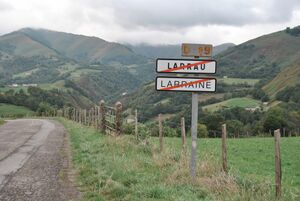Language documentation and description approaches in ecolinguistics: Difference between revisions
(added pic) |
No edit summary |
||
| Line 1: | Line 1: | ||
[[File:Lexantzu-zunharre kokapena.png|thumb|The village of Lexantzü is highlighted in the region of Xiberoa. ]] | [[File:Lexantzu-zunharre kokapena.png|thumb|The village of Lexantzü is highlighted in the region of Xiberoa. ]] | ||
[[File:Larrau and Larraine street signs.jpg|thumb|Signs when leaving Larraine/Larrau, in the Xiberoa province in the Basque Country of France.]] | |||
A '''language documentation approach applied in ecolinguistics''' could include documenting lesser-known and undocumented languages, specifically, local varieties, indigenous and ancestral languages. Data included in such a study would include consulting with archival data when available and conducting interviews with locals who can share insights into place names, plants, and a variety of environment-related phenomena. | A '''language documentation approach applied in ecolinguistics''' could include documenting lesser-known and undocumented languages, specifically, local varieties, indigenous and ancestral languages. Data included in such a study would include consulting with archival data when available and conducting interviews with locals who can share insights into place names, plants, and a variety of environment-related phenomena. | ||
Revision as of 23:44, 26 January 2023
A language documentation approach applied in ecolinguistics could include documenting lesser-known and undocumented languages, specifically, local varieties, indigenous and ancestral languages. Data included in such a study would include consulting with archival data when available and conducting interviews with locals who can share insights into place names, plants, and a variety of environment-related phenomena.
An example of this would be working with a speech community with whom a linguist conducts interviews with the intention to recognize local place and plant names (or anything that the community themselves wish to highlight) and document it in a way that benefits the community. Local signs could be created and sessions held to teach locals about different concepts and information discovered during the research as well as discuss how the research can be continued locally.
For example, a village in the Xiberoa region of the Basque Country located in modern-day France, called Lexantzü can point to reasons why doing so would be relevant. In Basque, Lexantzü, meaning ash tree, referring to the type of tree that grows locally in the area. The French name created during the nation-building phase of France is Lichans, which has an empty meaning.[1] This same village is combined with Zunharre administratively, so it is referred to as Lexantzü-Zunharre or Lichans-Sunhar. The same logic goes here Sunhar is a name adapted into with French spelling and pronunciation conventions while Zunharre refers to the elm tree that also grows locally. Many local places names refer to the environment and provide insight in what grows there among other meanings.
Additionally, Larraine, another local village in Xiberoa that roughly translates to "the higher ground" or "highlands" literally it can be understood as the "upper moor". The French version is Larrau, which has been adapted for the same reasons explained already above. This page is not to imply that these are anything special or out of the ordinary because in Scotland there is also "the Scottish highlands"[2] or "Kallio" an area of Helsinki, Finland that got its name for the stone that is known in the area. The object of this page is rather to highlight that local names have meanings and
Another example is of a town also in the Xiberoa region of the Basque Country called Atharratze in Basque and Tardets in French. The French name is once again a created French name and Atharratze is understood as "the last door" and specifically the last door before the mountains and has a special significance locally. There have been several interpretations of the towns name and its meaning; however, the meaning explained here tends to be the common interpretation [3]
- ↑ These anecdotes come from interviews conducted by Kayleigh Karinen during August and October 2022 while gathering data for her master's thesis.
- ↑ In Scottish Gaelic the region is referred to as "the place of the Gaels" [1]
- ↑ Also heard from data collected on a research trip and one consult suggested that the meanings in Basque be explained to create a sense of value for the local language and interests for those who do not speak Basque.

